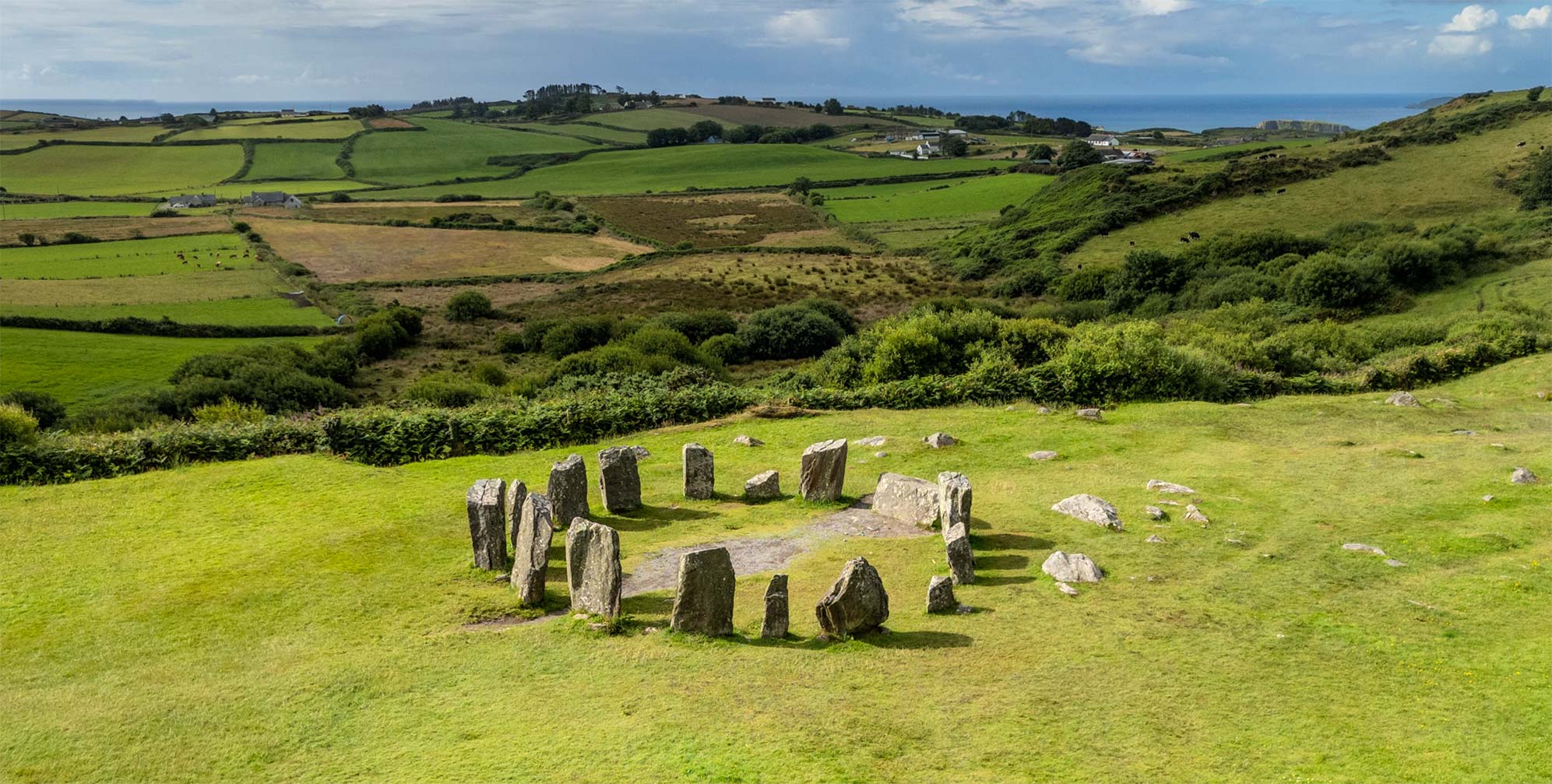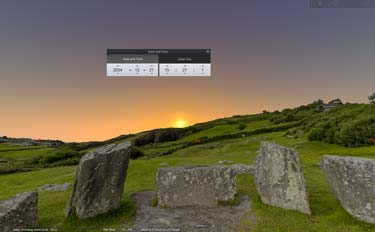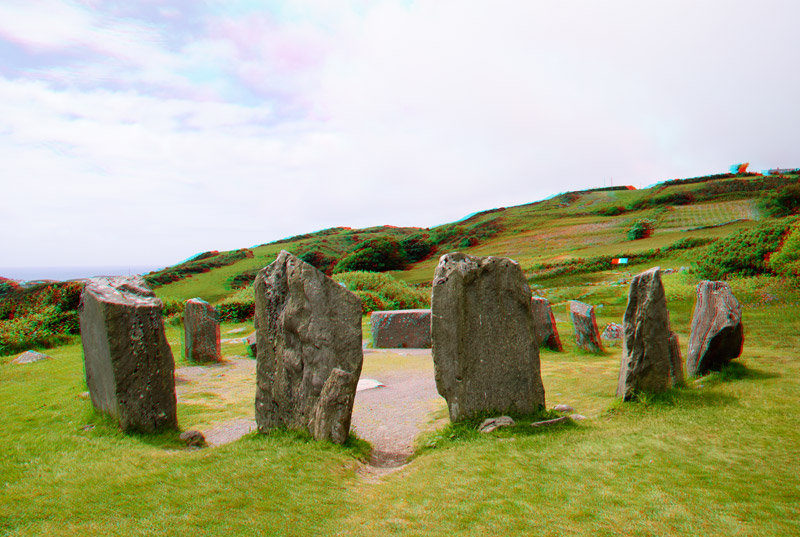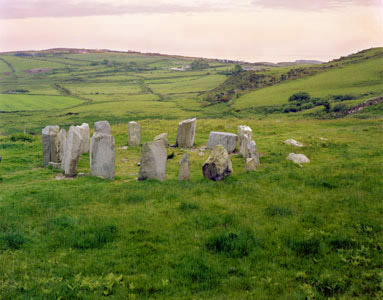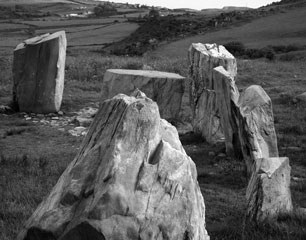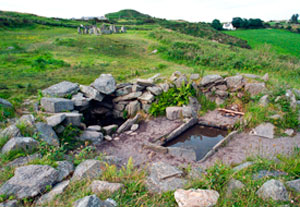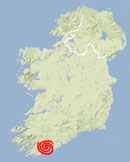10 Mar Drombeg Stone Circle
“In September, 1935, Boyle Somerville returned to Drombeg with a psychic, Miss Geraldine Cummings. She did not like the place. She felt it was…a place where animals, if not small children, were sacrificed at each winter solstice. She ‘saw’ a priest in blue and saffron robes standing at the altar of the recumbent about to kill his human offering… Drombeg was cursed. It was ‘guarded by spirits of darkness.’”
Aubrey Burl, A Guide to the Stone Circles of Britain, Ireland and Brittany, 1995 1
“I’ve heard it [the Banshee] seven times…And I said, ‘somebody’s going to die.’ And they did. People hear it. But, they wouldn’t know who would be at death’s door…But it isn’t heard so much now. Not so much. There might be a knock at the door, or something that way.”
John Hickey, recorded in 1979 2
Drag within the image to explore seven different views of the Drombeg Stone Circle and its associated cooking site and hutsites. The VR tour begins with an aerial view of all three. From there, hotspots will lead you each of these. To use the interactive map, click the “M” button in the toolbar, or type “M” on your keyboard.
The Drombeg Stone Circle is also known as the Druid’s Altar, a name that likely came into favor during the era of William Stukeley’s promotion of all things Druid in the middle of the eighteenth century. The name stuck, however, and when Drombeg local John Hickey, the man who heard the banshee nearby,3 began to speak about the circle of stones, the Druidic connection was the first thing on his mind (see interview: below, right).
Many of Ireland’s prehistoric monuments have a similar legendary connection to the Druids, accompanied by gruesome tales of human sacrifice, which are in most cases completely at odds with the archaeological understanding of the site. Blood and gore aside, the era of the historical Druids, in the late Iron Age, occurs thousands of years after the creation of most megalithic monuments. At Drombeg, however, there is just enough tantalizing evidence so that even the highly respected archaeologist Aubrey Burl could refer to the cremated bones found there as a “…dedicatory offering, perhaps a sacrifice…”4
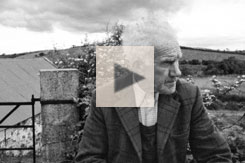
John Hickey believed that the Drombeg Stone Circle was built by the Druids. He also heard the Banshee nearby. (1979).
Drombeg (“the small ridge”) commands a glorious location at the head of a long green valley, presiding over a view that gently swoops down to the Atlantic 1.6 km (1 mi) away. Its organically sculpted, honey-colored stones form a circle that seems an unlikely candidate to be associated with the dying victims of human sacrifice or the blood-chilling wail of the banshee announcing the newly dead. One popular guidebook to sacred sites refers to Drombeg’s “rather dark reputation.”5 This, however, has not discouraged tourism, and may in fact have helped Drombeg to become the most-visited of the stone circles of Ireland.6
The site is classified as a “recumbent stone circle,” due to the one long (2.1 m or 6.9 ft) horizontal stone at the western edge of the 17-stone circle. Such circles are common in this region of Co. Cork and nearby Kerry. The example at Kealkil is the only other one that has been excavated. The Drombeg recumbent, darker than the other stones in the circle, is reputed to be the sacrificial altar. It is directly opposite the two stones, each more than two m (7 ft) tall, that seem to define a ceremonial entrance portal.7 The recumbent stone features two cup-marks and what has been interpreted as a depiction of either a stone axe or a human foot. You can decide for yourself in the close-up view enabled by a hotspot in the virtual-reality environment (above). The last rays of the setting sun on the winter solstice align from the portal to the center of the recumbent and nearly fit into a conspicuous notch in a hillside a mile away. This alignment may be noted in the 3D photograph, below left. Inexpensive 3D glasses are available here. According to a 1903 journal article, there was once a stone in the center of the circle, perhaps another aspect of the solar alignment.8
“…the rising and setting of some prominent celestial bodies was central to ritual traditions associated with death and the megalithic monuments in the prehistoric past, and embedded in the ideology and world view of people in the Neolithic.”
Dr. Frank Prendergast
Wouldn’t it be wonderful to have a time machine that could transport you back to an winter solstice sunset sometime in the Bronze Age where you could witness the last glimmer of the sun’s rays over the recumbent stone at the Drombeg Stone Circle? After that sunset, you would be able to look up into the night sky, free of modern-day light pollution and industrial haze, and see perhaps as many as 6000 stars, rather than just the few hundred visible today.
The next best thing to such a time machine is the free and open-source program Stellarium, a planetarium simulation which provides realistic visualizations of the positions of celestial bodies for any time in the past, present, or future. It is able to compute and simulate the night sky for any specified location on earth. Stellarium is available for most computer platforms and may be downloaded here.
In 2021 cultural archeoastronomer Dr. Frank Prendergast (Technological University Dublin, Emeritus) was commissioned by the National Monuments Service to create a Newgrange-specific landscape model that could be imported into Stellarium.
Inspired by Dr. Prendergast’s work, we repurposed one of our Drombeg Stone Circle VR nodes into a Drombeg landscape model for Stellarium. This file may be downloaded here.
Drombeg is almost 9.5 m (31 ft) in diameter and forms a nearly perfect circle. Of the 17 stones, two modern replacements were put into the sockets of missing originals after E.M. Fahy’s 1958 excavation.9 A pair of stones, the 5th and 6th going clockwise from the recumbent (see VR environment), seemed to Fahy distinctly suggestive of a pointed male upright and a very broadly fecund female. Fahy suspected “…the possibility that a fertility cult was an integral part of the beliefs of the circle builders.”10 Other observers, however, may conclude that sometimes a stone is just a stone.
It was Fahy’s discovery of human remains, coupled with his reconstruction of the events that may have led to their placement in the circle, that have provided some corroboration to the lurid 1935 vision of the psychic.
Fahy removed the graveled pavement within the circle, placed there by the original builders, who may have been from the Bronze or the early Iron Age.11 He then discovered a dark circular patch, 25 cm. (10 in.) in diameter, almost exactly in the center of the circle, covered by a dusting of charcoal. When the materials in that area were examined they were found to contain bits of cremated human bone. At the edge of the deposit he found, standing on edge, large potsherds, which he determined were from an already-broken vessel used for the placement of the burial deposit. Inside were other small pieces of pottery and burnt pebbles, all mixed together with cremated bone, charcoal, and soil. When excavation was complete, neither the base nor the rim of the pot was found.12 Fahy concludes, with a degree of certitude unusual for a scientist, “…there is no room for speculation in the matter, that the pottery fragments were introduced into the burial as part of the intimate mixture of materials which constituted the upper layer of the deposit.”13
Conceiving a dramatic tableau from the archaeological finds uncovered by Fahy in 1958, Aubrey Burl constructed this narrative for the Drombeg site in his 1995 guidebook:
“Nearby there had been a pyre on which the body of an adolescent had been consumed. The cremate bones had been raked up and placed in an already broken pot, its base missing, wrapped round with thick cloth. This dedicatory offering, perhaps a sacrifice, was taken to a shallow pit near the middle of the ring where it was buried…
Needing fertile soil and good harvests the people of Drombeg turned to the forces of nature, supplicating them in a ring with its symbolism of fecundity. They offered human remains, rich dark soil, and they covered the offerings under a…thick layer of gravel. The compacted earth and trodden pebbles at the entrance showed how for generations descendants had returned at midwinter to reaffirm their need for protection.” 14
Just 40 m (130 ft) to the west sits the proof that Drombeg continued to be used into the late Iron Age, perhaps to house and feed celebrants arriving to commemorate an echo of the site’s original ritual.15 What Somerville in 1909 believed to be a second stone circle turned out, after excavation by Fahy in 1959, to be the foundations of two conjoined circular huts. These are linked by a 9 m (30 ft) stone walkway to a fulacht fiadh,16 thought by most to be an outdoor cooksite. There, water in a trough was boiled by dropping in red-hot stones from the adjacent hearth. It may have served as an Iron Age crock-pot, with sides of venison placed in the boiling pool to prepare a communal feast. Carbon dating of the embers in the hearth demonstrated that the site was still in use at the end of the fifth century CE. It’s also possible that the huts and cooksite were used as a seasonal shelter by bands of hunters who gave not the slightest thought to the ancient circle of stones in the next field.
Experiments conduced at the site by Fahy when he excavated the fulacht fiadh demonstrated that he could heat the 265 liters (70 gallons) of water in the trough by adding stones that were glowing after baking three hours in the hearth. Eighteen minutes later, the water was boiling vigorously, and it remained hot two hours later.17
Professor Michael O’Kelly took such experimentation a bit further six years earlier while excavating a fulacht fiadh at Ballyvourney, also in Co. Cork. Using a 4.5 kg (10 lb) leg of mutton, he tied it inside a bundle of straw to keep out the muddy grit from the water. He then lowered the bundle of meat into the boiling water (see photographs in gallery).
“…and when it had sunk out of sight the putting in of the hot stones was continued, a stone every few minutes in a different part of the trough so as to keep the whole of the water simmering rather than boiling. This was kept up for three hours and forty minutes, a time based on the modem recipe of ‘twenty minutes to the pound and twenty minutes over.’
By the end of this time, the surface of the water was covered by a scum of globules of fat mixed with ashes and fragments of charcoal, these latter items having gone in with the hot stones. The water itself had become opaque from the amount of mud churned up from the bottom and held in suspension in it.
Seeing it thus, we wondered if the meat would be edible, but when taken out at the end of the stated time and removed from its covering of straw it was found to be cooked through to the bone and to be free of all contamination!…Thus, we satisfied ourselves that such a trough made in the ground could be used effectively for the cooking of meat in the manner described in the early Irish literature.” 18
It is altogether possible, according to more modern interpretations, that the 1950s scholarship on the fulacht fiadh was excessively influenced by long-cherished images taken from the traditional literature, in which the legendary champions of Ireland camped and cooked at such sites. The fact is, at none of the fulacht fiadh digs in Ireland, nor at the “burnt mounds, as they are called in Britain, has any evidence of cooking or eating been uncovered. No bones were found, nor any refuse heaps.19 Contemporary research now considers other possibilities for the use of fulacht fiadh: bathing, curing meat, making porridge, dying cloth, tanning leather, processing cremations, and even making beer.20
Whatever were the ritual practices of the stone circle and the fulacht fiadh, the Drombeg site continued to convey a sense of its power into the modern era. In 1979 we asked Mr. O’Brien, an 80-something farmer having a drink at a pub in nearby Glandore, what he thought about the place. He considered it remarkable that “the whole area was covered in thorn bushes, but none would ever grow inside the circle.”21 He said the farmers in the area always respected these sites. Even if they were located in the center of a fertile field, they would plough around the stones rather than disturb them.
With the monument under state care, there is no further threat from local farmers or from the likes of those who removed two of the circle’s stones many years ago. Now the only danger to Drombeg may arise from an excess of affection, as the site receives each day a continuous stream of visitors from all over the world. They are the partisans of Firbolgs or Fomorians, the amateur archaeologists, the proponents of ley lines, the diviners and the dowsers, all with the best of intentions. They are filled with images of Druids, excited by the solar alignments of ancient astronomers, and they can practically smell the joint of mutton stewing in the fulacht fiadh. Unfortunately, some few of them leave more than their footprints at the stone circle; some leave wax residue from the candles or incense burners they set on the ancient altar. Some have actually built a campfire in the center of the circle, leaving unsightly scars at the site in an ill-considered attempt to evoke the spirit of the original—forever mysterious—rituals performed here.22
Even with all the evidence left by the bones and potsherds, archaeologists can only speculate about the ceremonies that occurred at this site two or more thousand years ago. In 1959 Fahy wrote:
“We cannot say what were the precise ritual ceremonies at Drombeg, but…once the initial dedication had taken place, the community, secure in the knowledge that the mortal remains of the cremated person were present within the circle, proceeded with their further ceremonies in such a manner that no material evidence of them was left in the soil” 23
There is also another possibility. Perhaps the elaborate rock art that was left for us to ponder on the passages of the Stone Age tombs such as Newgrange and Loughcrew over the millennia evolved into even more elaborate carvings—but made of wood—created to accompany the Bronze Age stone circle sites. As Ronald Hutton suggested about the passage tombs in 1991, “Wood rots, stone doesn’t. The [rock] art…might have been unique to those tombs, or it might have been minuscule in quantity compared with woodcarvings which have perished.”24
Without a time machine that might allow us to observe the rituals of Drombeg’s builders, we have to admit that anything is possible, from the sublime to the less so. Before the stone circle was acquired by the state, Norman Damery’s mother’s family owned it. In a 2004 account, Damery said his family had always used the recumbent stone as a picnic table.25
Click here to see all the notes from this page.
Drombeg Stone Circle, Co. Cork
Nearest Town: Glandore
Townland: Drombeg
Latitude: 51° 33′ 53.57″ N
Longitude: 9° 5′ 15.30″ W
external links:



